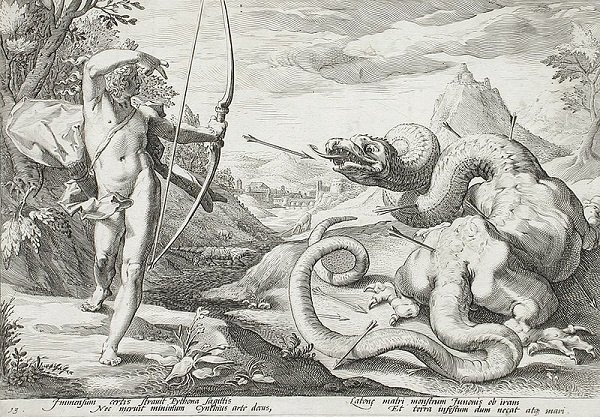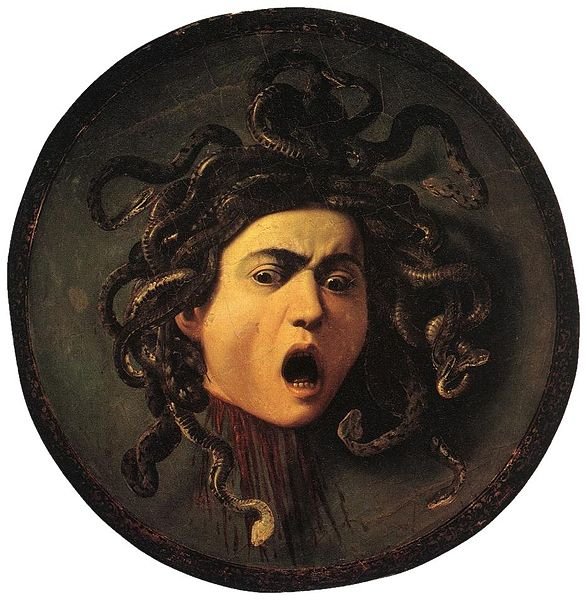Magical Objects Series - Part Three: Greek Mythology
A list of 10 objects from Greek mythology.
Trident of Poseidon.
Poseiden sculpture Copenhagen (W.Commons)
The weapon of Poseidon, the god of the sea in Greek mythology (Neptune in Roman mythology).
When he strikes the earth in anger, his trident causes powerful earthquakes.
In the sea, Poseidon uses the trident to stir up tidal waves and sea storms.
Talaria.
Hermes’ winged sandals - statue at British Museum (own photo)
The winged sandals of the messenger god, Hermes, which allows him to fly.
Apollo’s bow and arrow.
Apollo killing the python (W.Commons)
Apollo is the god of light, music and the arts, archery, oracles, and knowledge.
His bow is crafted of the sun’s rays as is the arrow.
The arrow could cause either health or famine, and death in sleep.
Armour of Achilles.
Achilles fighting against Memnon (detail from grave amphora found in southern Italy) - Leiden Rijksmuseum voor Oudheden - photo by Jona Lendering (W.Commons)
Said to be impenetrable, the armour was created by Hephaestus, the god of blacksmiths, carpenters, craftsmen, fire, metalworking, and volcanoes; he made all the weapons of the gods.
I find it a little confusing sometimes when the names of the Greek deities are interchanged with their Roman counterparts, as in the title of this painting by Antonio Balestra - instead of Hephaestus, the name of his Roman counterpart, Vulcan, is used.
‘Vulcan Giving Thetis (Achilles’ mother) Armour for Achilles’ - Antonia Balestra (W.Commons)
The Argo.
‘Argo’ by Konstantinos Volanakis (W.Commons)
The ship of Jason and the Argonauts.
Jason, a Greek mythological hero and leader of the Argonauts, was the great grandson of Hermes, and was married to the sorceress Medea.
‘Jason and Medea’ by John William Waterhouse (W.Commons)
The Argonauts took their name from the ship, the Argo, named after its builder, Argus, said to have been instructed by the goddess Athena.
Building of the ship Argo (W.Commons) - Athena (left) adjusts the sail; Tiphys (centre) holds the yard; Argus (right) sits across the stern.
The prow of the Argo, made with a piece of oak from Dodona, a forest sacred to Zeus, could speak and deliver prophecies.
In the years before the Trojan War, Jason led the Argonauts, a band of heroes, to Colchis to find the Golden Fleece.
This was the fleece of the golden, winged ram, Chrysomallos.
Chrysomallos, the golden-fleeced ram, with Phrixus and Helle (W.Commons)
It was sent by Nephele, the cloud-nymph, to rescue her children, Phrixus and Helle, who were about to be sacrificed to the gods.
The ram carried them to Colchis at the far end of the Black Sea, then instructed Phrixus to sacrifice him to the gods and lay his fleece in the grove of Ares.
Afterwards, Chrysomallos was placed among the stars as the constellation Aries.
Circe’s staff.
‘Circe offering the Cup to Odysseus’ by John William Waterhouse (W.Commons)
Circe was the daughter of Helios, the sun god, and the Oceanid nymph, Perse.
Deemed a minor goddess, Circe was also an enchantress, renowned for her extensive knowledge of potions and herbs.
Circe applied her knowledge along with her staff to transform her enemies and those who offended her into animals.
The best-known example of this is when Odysseus visits her island on his way home from the Trojan War.
When his men insult her, Circe turns them into swine, but Odysseus persuades her to return them to human form.
Ring of Gyges.
This magical artifact granted its owner the power of invisibility.
Gyges was the founder of the Mermnad dynasty of Lydian kings, Lydia being an Iron Age kingdom of western Asia Minor.
Although different accounts are given of how he rose to power, all agree that he was originally a subordinate of King Candaules of Lydia.
Gyges killed Candaules and seized the throne, taking Candaules’ queen as his wife.
According to the myth as recounted by Glaucon, Plato’s older brother, an unnamed ancestor of Gyges, a shepherd, worked for the ruler of Lydia.
While tending his flock, he discovered a chasm that had been revealed after an earthquake.
Inside, he discovered a tomb containing the remains of a being larger than a man.
Seeing a golden ring on the corpse’s finger, he took it for himself.
Later, he realised when he adjusted the ring, he became invisible.
After he somehow arranged to become one of the king’s messengers, he used his power of invisibility to seduce the queen, who helped him murder the king, after which he became king of Lydia.
Necklace of Harmonia.
Polynices offering Eriphyle the Necklace of Harmonia (W.Commons)
The necklace was made by Hephaestus who gifted it to Harmonia, the goddess of harmony and concord, on her wedding day.
Although the necklace allowed any woman who wore it to remain eternally young and beautiful, it was also cursed and brought great misfortune to all Harmonia’s descendants, culminating with the story of Oedipus.
The reason Hephaestus made this cursed necklace specifically for Harmonia was to exact revenge on his wife, Aphrodite, for her infidelity.
The goddess of love had had an affair with Ares, the god of war, and Harmonia was their daughter.
The Harpe and the Cap of Invisibility.
Statue of Perseus in Florence (W.Commons) with the Harpe (sword) and the Cap of invisibility
The last 2 items are listed together as both were used by the hero Perseus, son of Zeus and a mortal woman, Danaë, whose father, Acrisius, was the King of Argos.
When the Delphi Oracle told Acrisius that the son his daughter would, one day, have was fated to kill him, he had Danaë imprisoned in a chamber.
The chamber, however, was open to the sky, which allowed Zeus to come to Danaë in a shower of gold, and Perseus was conceived.
Afraid for his future but not wanting to provoke Zeus by killing his offspring, Acrisius banished Danaë and her baby, casting them adrift in a wooden chest.
Mother and son made it to the island Seriphos where they were found by the fisherman, Dictys, who helped them and raised Perseus to manhood.
Dictys brother, Polydectes, was the ruler of the island, and, by the time Perseus was an adult, had come to want Danaë for himself.
But Perseus didn’t trust him and shielded his mother from Polydectes’ unwanted advances.
Polydectes hatched a plan to rid himself of Perseus, which involved inviting guests to a banquet who each had to bring gifts, specifically horses.
Perseus had no horse, so he asked Polydectes to name a gift and he would bring it.
Polydectes named the head of the only mortal Gorgon, Medusa, whose gaze turned people to stone.
Medusa’s parents were Phorcys and Ceto, the god and goddess associated with the hidden dangers of the sea, and of sea-monsters.
Phorcys & Ceto - Bardo National Museum, Tunis (theoi.com)
Their children included Ekhidna, the fearsome she-dragon, the sea-monster Scylla, and the Gorgon sisters, Stheno, Euryale and Medusa.
For some reason, Medusa was the only one of her siblings who was mortal, and seemingly more beautiful than the rest.
Medusa was said to have been a priestess in Athena’s temple where, depending on which version of her story you read, she either had an affair with Poseidon or was taken against her will.
Furious, Athena transformed Medusa’s hair into serpents; although usually seen as a curse, some say it was a blessing for it protected Medusa against unwanted advances.
Medusa by Carvaggio (W.Commons)
To help him in his quest, the goddess Athena instructed Perseus to find the Hesperides, the nymphs of the evening and the golden light of sunset, the guardians of the tree that produced golden apples in Hera’s orchard for they had the weapons needed to defeat the Gorgon.
‘The Garden of the Hesperides’ by Frederic Leighton (W.Commons)
After making his way to the Gorgons’ cave, Perseus successfully approached the sleeping Medusa by observing her reflection in the polished shield Athena had given him.
The adamantine sword he used to decapitate Medusa was said to have been given to Perseus by Zeus, and it was called a Harpe, a type of sword with a sickle protrusion along one edge near the tip of the blade.
From Medusa’s neck sprang Pegasus and Chrysoar, a giant wielding a golden sword, her children with Poseidon.
‘Perseus on Pegasus Slaying Medusa’ by John Singer Sargent (W.Commons) with the goddess Athena
Perseus then donned the cap of invisibility, which belonged to Hades, the god of the underworld, to escape Medusa’s immortal older sisters, Stheno and Euryale.















